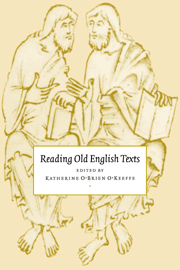Book contents
- Frontmatter
- Contents
- List of contributors
- List of abbreviations
- Note on the text
- Introduction
- 1 The comparative approach
- 2 Source study
- 3 Language matters
- 4 Historicist approaches
- 5 Oral tradition
- 6 The recovery of texts
- 7 At a crossroads: Old English and feminist criticism
- 8 Post-structuralist theories: the subject and the text
- 9 Old English and computing: a guided tour
- Suggestions for further reading
- Index
9 - Old English and computing: a guided tour
Published online by Cambridge University Press: 18 December 2009
- Frontmatter
- Contents
- List of contributors
- List of abbreviations
- Note on the text
- Introduction
- 1 The comparative approach
- 2 Source study
- 3 Language matters
- 4 Historicist approaches
- 5 Oral tradition
- 6 The recovery of texts
- 7 At a crossroads: Old English and feminist criticism
- 8 Post-structuralist theories: the subject and the text
- 9 Old English and computing: a guided tour
- Suggestions for further reading
- Index
Summary
One day, about three years ago, I found myself walking toward the library with a colleague who posed the question whether the computer had produced a theoretical revolution in literary studies or had merely enabled scholars to do more effectively what they had been doing all along. The question seemed an appropriate one to discuss as we strolled through the Academical Village of the University of Virginia, in which Thomas Jefferson so brilliantly wedded his visions as architect and educational philosopher; for Jefferson's phrase ‘Academical Village’ had recently been adopted as the working metaphor for the University's computer network, suggesting that the network's purpose was not so much to transform our educational and scholarly mission as to realize more perfectly an age-old dream. The question then had – and still has – no obvious answer; but it seems a fundamental one, and the reader should keep it in mind as we tour some of the on-line resources forthcoming or available to students and scholars of Anglo-Saxon England.
The Dictionary of Old English and the electronic text
The history of the computer in Old English scholarship goes back to the 1960s, when work began on various computer-generated concordances. By far the most ambitious of these projects was undertaken at the University of Toronto under the direction of the late Angus Cameron, who, as part of a plan for a new Dictionary of Old English, proposed to generate an electronic database containing everything written in Old English.
- Type
- Chapter
- Information
- Reading Old English Texts , pp. 192 - 215Publisher: Cambridge University PressPrint publication year: 1997
- 2
- Cited by

